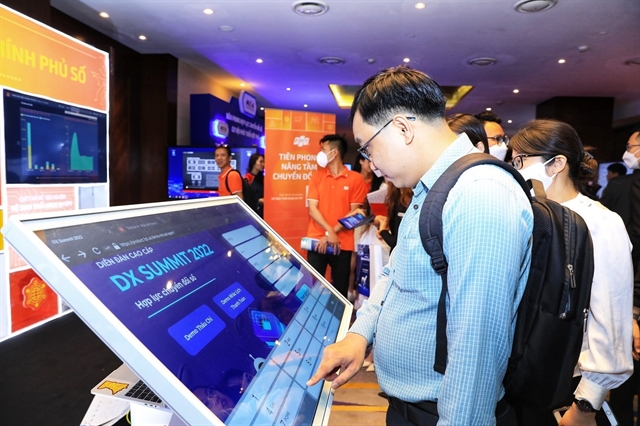 Opinion
Opinion

 |
| Delegates at the Việt Nam-Asia Digital Transformation (DX) Summit in May 2022. — VNA/VNS Photo Tuấn Anh |
Việt Nam News Agency (VNA) spoke to An Ngọc Thao, Deputy Secretary-General of Việt Nam Software Association (VINASA) on the progress of digital transformation.
According to statistics from the Ministry of Information and Communications, Việt Nam has around 67,300 businesses operating in digital technology, an increase of 3,500 compared to December 2021. What is your evaluation on the current progress on digital transformation?
These figures speak volumes about the strong digital transformation that is taking place in Việt Nam. Vietnamese businesses have made a significant contribution to this progress.
From State-owned to private enterprises, from large corporations to small and medium-sized enterprises (SMEs), especially technology firms, all are currently going under a powerful transformation.
In the past three years, technology companies have been active and creative in their contributions to digital transformation in Việt Nam by leading the way with their own technology. At the same time, they also create platforms and provide technology products and services to other businesses to start their own change process.
How important is digital transformation to the existence of business now?
The media has been talking about how inevitable is digital transformation, or even how the enterprises will not survive if they do not follow the changes.
However, I think it should be put it this way: everything is changing, and whether an individual or organisation is transforming digitally or not, society as a whole is, and every components in our society is already in the process of digital transformation.
The story is no longer about whether to transform or not, but rather how these organisations approach the matter: actively or passively?
For individuals and organisations that follow the active approach, they will have better preparation for the next stages, avoid lagging behind and quickly gain a competitive edge for themselves.
I think that at this time, we should no longer talk about how crucial digital transformation is but rather find out what approach to take in this process.
What are the necessary conditions for Việt Nam to support businesses in their digital transformation?
Here I want to talk about the national digital infrastructure, which is categorised into six groups.
Việt Nam’s legal framework to accelerate digital transformation is being completed at a rapid speed. From the government to ministries and departments such as the Ministry of Information and Communications (MIC), Ministry of Planning and Investment (MPI), Ministry of Health (MoH), Ministry of Education and Training (MoET), all are putting in the effort to develop a legal framework for units under their management to transform digitally. The framework is taking shape and in the future will be the leverage for digital transformation.
Việt Nam’s connectivity infrastructure is considered one of the best in the region and the world. The country has more than one million kilometres of fibre optic cable, 98 to 99 per cent coverage of 4G network, and the 5G network is being commercialised. In Việt Nam internet service and quality is inexpensive and good.
Data infrastructure has also been a government’s focus for investment. In addition to six national databases prioritised for implementation in the fields of population, land, business registration, demography, finance, and social insurance, there are also industry, local and organisational information storage which are being systemised and integrated into the national data in the future.
After the big data is compiled and transformed into open data for access and use by various organisations, these databases will demonstrate its crucial role in promoting digital transformation, and further, to build an e-government.
In addition to these, more than 40 data centres are being built by major technology companies in Việt Nam (including Viettel, VNPT, FPT), which are aimed to become super data centres that help address big data issues in Việt Nam.
Regarding the infrastructure that applied technology solutions - this is about the software industry and the work of VINASA members in recent years.
Businesses providing technology services in Việt Nam are regarded by the international community as having good capacity and competitiveness.
Việt Nam still has lots of room to grow in digital equipment. However, Vietnamese companies have been striving to invest and develop products ‘Make in Việt Nam’ to master the technology and meet the demand of the domestic market, and further for exports.
Human resources in the technology industry also needs to be a focus in the future in order to meet the demands both in quality and quantity.
What are the VINASA programmes to assist companies in their digital transformation?
VINASA is one of the first to propose digital transformation in Việt Nam. The association has had multiple programmes and discussions on this change since 2017 - 2018.
At the current stage, our association has decided on a new direction, switching from discussion to action.
In 2022, VINASA has approved a new executive committee and agreed that digital transformation is a matter of utmost importance. We set the action theme for the year 2023 as “Cooperation for digital transformation.”
For SMEs, they can simply go to the programme website at https://dx4sme.vn/ to access the digital transformation manual.
Each module is less than 10 pages, written in a simple and easy-to-understand manner, which helps companies understand what they have and what they lack, especially the missing platforms and software needed for the digital transformation process, and what should be their next steps.
We are also working with the MPI to deploy a direct support programme, which provides training for companies in different localities, helping and accompanying them in their digital transformation.
According to statistics from VINASA, there are currently 90 per cent of businesses not knowing how to transform digitally, 72 per cent not knowing where to begin the process, and 69 per cent not sure of which solutions or service providers to choose for a quick and effective transformation. What are the main reasons for these figures?
The first reason is that companies are lacking information, and therefore lacking proactivity. In reality, they usually have to focus on ‘making ends meet’, and so finance and human resources are the first priorities.
For SMEs, they think that if they are not undergoing digital transformation now, they won’t die tomorrow, and so it is not a matter of focus.
That mindset could mean that businesses, and business owners, are not having sufficient information. This is because if they only focus on making ends meet today and are not ready for digital transformation at the most fundamental levels - mindset and determination - then tomorrow, their competitiveness will be even lower, and their long-term development will meet even greater obstacles.
The solution here is to actively communicate the message through multiple channels and formats to reach these business owners.
In the future, there will be more specific programmes to guide and shape digital transformation, so that SMEs can better learn, understand, and therefore change their perspectives and be ready for the transformation.
What is your advice for businesses that are not ready, or not knowing how to start the digital transformation process?
There are currently numerous programmes that assist businesses in digital transformation. The MIC and MPI are also providing free consultancy for enterprises that want to start the process.
Training programmes are also being offered for free or at a small price throughout the year, focusing on specific industries for businesses to choose from.
For companies that are VINASA members, they can contribute to the development of the National Digital Transformation Framework, which offers a 30 per cent price reduction for SMEs to access technology platforms for digital transformation.
With the aim of cooperating for digital transformation, the government, ministries and departments, localities, and technology associations, businesses, experts, all provide programmes to support business in the process.
Therefore, my advice to businesses that are not ready, not knowing how to transform, is to look for consultancy services and experts to start the process as soon as possible. — VNS




